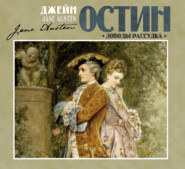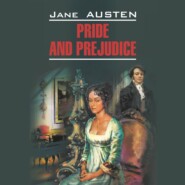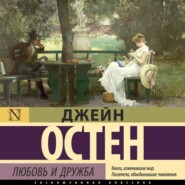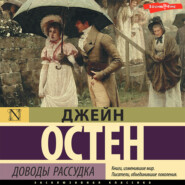По всем вопросам обращайтесь на: info@litportal.ru
(©) 2003-2025.
✖
The Jane Austen Collection: Pride and Prejudice, Sense and Sensibility, Emma and Northanger Abbey
Настройки чтения
Размер шрифта
Высота строк
Поля
The Jane Austen Collection: Pride and Prejudice, Sense and Sensibility, Emma and Northanger Abbey
Jane Austen
Collins Classics brings you a selection of the best-loved novels by Jane Austen, including ‘Pride and Prejudice’ which, in 2013, celebrates the 200th anniversary of its publication.Complete with a Life & Times section, which offers insight into the author, her works and the time of publication, and a handy glossary adapted from the Collins English Dictionary, this Collins Classics Collection will enhance your reading experience of Jane Austen’s novels.PRIDE AND PREJUDICE: Austen's best-loved tale of love, marriage and society in class-conscious Georgian England still delights modern readers today with its comedy and characters.SENSE AND SENSIBILITY: Spirited and impulsive, Marianne Dashwood is the complete opposite to her controlled and sensible sister, Elinor. It is through their shared experiences of love that both sisters come to learn that the key to a successful match comes from finding the perfect mixture of rationality and feeling.EMMA: Beautiful, rich, self-assured and witty, Emma Woodhouse delights in match-making those around her, with no apparent care for her own romantic life. Delightful, engaging and entertaining, Emma is arguably Austen's most well-loved social comedy.NORTHANGER ABBEY: A coming-of-age novel, Austen expertly parodies the Gothic romance novels of her time and reveals much about her unsentimental view of love and marriage in the eighteenth century.
COLLINS CLASSICS - THE JANE AUSTEN COLLECTION
Pride and Prejudice
Sense and Sensibility
Emma
Northanger Abbey
JANE AUSTEN
Contents
History of Collins (#ulink_071809f3-6367-5d3b-8b00-1167065ab7bf)
Life & Times (#ulink_ab045f08-e952-5b44-8471-78560671fb68)
About the Author (#ulink_427c2f2d-a23f-5160-bf99-e0d42d5d0627)
Austen’s Literary Genre (#ulink_f2b0e7ee-b189-5860-bc8f-7009d4dc3dc1)
Pride and Prejudice (#uc65ade40-217f-5381-981c-a5b435cf630c)
Sense and Sensibility (#litres_trial_promo)
Emma (#litres_trial_promo)
Northanger Abbey (#litres_trial_promo)
Classic Literature: Words and Phrases (#litres_trial_promo)
Copyright (#litres_trial_promo)
About the Publisher (#litres_trial_promo)
History of Collins (#ulink_d12127f8-813b-5aa4-bc0c-065ffdb46018)
In 1819, Millworker William Collins from Glasgow, Scotland, set up a company for printing and publishing pamphlets, sermons, hymn books and prayer books. That company was Collins and was to mark the birth of HarperCollins Publishers as we know it today. The long tradition of Collins dictionary publishing can be traced back to the first dictionary William published in 1824, Greek and English Lexicon. Indeed, from 1840 onwards, he began to produce illustrated dictionaries and even obtained a licence to print and publish the Bible.
Soon after, William published the first Collins novel, Ready Reckoner, however it was the time of the Long Depression, where harvests were poor, prices were high, potato crops had failed and violence was erupting in Europe. As a result, many factories across the country were forced to close down and William chose to retire in 1846, partly due to the hardships he was facing.
Aged 30, William’s son, William II took over the business. A keen humanitarian with a warm heart and a generous spirit, William II was truly ‘Victorian’ in his outlook. He introduced new, up-to-date steam presses and published affordable editions of Shakespeare’s works and Pilgrim’s Progress, making them available to the masses for the first time. A new demand for educational books meant that success came with the publication of travel books, scientific books, encyclopaedias and dictionaries. This demand to be educated led to the later publication of atlases and Collins also held the monopoly on scripture writing at the time.
In the 1860s Collins began to expand and diversify and the idea of ‘books for the millions’ was developed. Affordable editions of classical literature were published and in 1903 Collins introduced 10 titles in their Collins Handy Illustrated Pocket Novels. These proved so popular that a few years later this had increased to an output of 50 volumes, selling nearly half a million in their year of publication. In the same year, The Everyman’s Library was also instituted, with the idea of publishing an affordable library of the most important classical works, biographies, religious and philosophical treatments, plays, poems, travel and adventure. This series eclipsed all competition at the time and the introduction of paperback books in the 1950s helped to open that market and marked a high point in the industry.
HarperCollins is and has always been a champion of the classics and the current Collins Classics series follows in this tradition – publishing classical literature that is affordable and available to all. Beautifully packaged, highly collectible and intended to be reread and enjoyed at every opportunity.
Life & Times (#ulink_90307c60-eeea-535a-bc3a-8fa5093e5152)
About the Author (#ulink_533a8e39-a7a1-528d-ab88-895747fc1241)
Jane Austen was born into a moderately wealthy family in 1775, during the reign of King George III. Her family was typically large as was customary at the time in order to counter the possibility of early death by producing many offspring. She had five older brothers, one older sister and a younger brother.
Austen was born in a small village in Hampshire, England, named Steventon, where she lived until 1800. She would read out her early attempts at novels to her family and refine and hone the words based on their response. In this way she completed first draft manuscripts of Sense and Sensibility and Pride and Prejudice, although they were originally titled Elinor and Marriane and First Impressions respectively. She also wrote the manuscript for Northanger Abbey in this way, which was initially given the name Susan.
In 1800 Austen’s father, William George Austen, decided to move to the City of Bath. At that time, it was normal for unmarried daughters to live with their parents, so Austen found herself moving to a Georgian city, having previously known only a rural life. Despite her association with Bath, it seems that urban society did not really suit Austen, and her output as a writer fell away for the next few years, until she returned to the countryside. Austen’s father died in 1805, leaving the family financially insecure. Austen’s mother, Cassandra, took Jane and her sister, Elizabeth Cassandra, to Southampton in 1806, where they were based with her brother Frank and his wife. Finally, in 1809, Austen’s brother Edward offered the three of them a cottage in his grounds at Chawton, another village in Hampshire.
With new found security and a more settled lifestyle, Austen found herself able to write once more. By 1811 she had become a published novelist with Sense and Sensibility. There followed, Pride and Prejudice in 1813, Mansfield Park in 1814 and Emma in 1815. At about this time Austen began to feel unwell and suffered from a progressive disease, which saw her health decline. She continued to write but became increasingly infirm until she succumbed in December 1817 at the age of 41. Her final novel, Persuasion, was published posthumously along with Northanger Abbey shortly after her death. There is also a seventh, incomplete, manuscript named The Brothers or Sanditon, which she started to write in 1817, even though her health was deteriorating
There has been considerable speculation about the nature of Austen’s illness. The two most likely culprits are Addison’s disease and Hodgkin’s lymphoma, both of which were described and named later in the 19th century. It is known that she suffered bouts of fatigue and difficulty in walking. She eventually died in the City of Winchester and was laid to rest in Winchester Cathedral.
The wind of change was so strong following Austen’s short life that her novels fell out of favour quickly with the onset of the Victorian era. Her books continued to sell, but they were not considered fashionable, as people gravitated towards the gritty realism portrayed by Dickens, Hardy and their contemporaries. The public wanted to read about characters exposed to the harshness of life without privilege, as opposed to Austen’s characters whom were generally rather comfortable and concerned themselves with matters of little real consequence.
Austen was actually using elements of her own, relatively comfortable life to weave her tales of fiction, so to her they were genuine situations and circumstances worthy of analysis. She also never married, so her angst was focussed on pondering matters of the heart. In many ways she lived vicariously through her characters, allowing them to experience the intimacies that she craved, but that eluded her all of her life.
Austen’s Literary Genre (#ulink_a132d895-1c35-5b8a-aa15-afd6c9fc2d09)
It is interesting to note that many contemporary authors choose to give their novels period settings as their plots often rely on rules of formality and etiquette and characters must behave in a certain way to ensure that a narrative will work. Jane Austen was living and writing in a time when such rules were part of polite society and can be seen as the originator of this plot devise. It is fair to say that societal rules reached their zenith of priggishness during Austen’s lifetime. It was all about defining oneself in terms of class and wealth, so that there were very clear guidelines about what one should and should not do and how one should behave.
Austen was herself born into a family at the lower end of the English hierarchical stratum known as the gentry, which was situated beneath the nobility. In modern terms she would have been considered well educated and privileged. This gave Austen a certain vantage point as a writer, for she rubbed shoulders with people both above and below her on the social scale.
Austen was a humanist and made it abundantly clear that she thought little of the notion that some people were better or worse than others simply through accident of birth. In essence, her literature is defined by her desire to express that it is what goes on inside a person that matters above and beyond other concerns. Austen makes theatre of the absurdities that she observes in polite society because she has an innate cynicism, but she always avoids being vitriolic in her prose.
It is this delicate balancing act between crafting an engaging narrative and passing comment with subtle allegory that made her novels a success then and now. Austen expertly translates her criticism of the human condition into witty and insightful prose. Through her satirical eye, the characters become relevant to the reader as they recognise elements or traits of themselves or others in the disparate personalities. Although such psychological connectives were more pertinent in society at the time that Austen was writing, they still resonate today because people frequently gravitate towards societal rules, albeit in a less formalized way. Therefore, it is still easy to relate to Austen’s stories through the experiences of her characters and the situations and events that arise in her novels are timeless and emotive.
Austen was not, however a romanticist. She was at the cutting edge of English literary fiction, just as the artist Joseph Turner was at the cutting edge of English painting. Both were born in the same year, 1775, and both used their creativity to document the modern world they knew. Austen is often described as a sentimental novelist, because her themes are primarily about the exploration of human feeling and emotion. This was a concept relatively new to society at the time, not least because everyday life hadn’t yet afforded people the luxury of the leisure time necessary for such self-indulgences. Indeed, during Austen’s lifetime it was still only the wealthy with time on their hands. Most were far more concerned with the hardships and realities of making a living and raising a family. That is largely why Austen’s novels focus so much on the upper echelons of society, as only the idle rich were not preoccupied by such matters of survival.
Austen’s life was short, but it spanned the turn of the 19th century, when the Industrial Revolution was in full spate. After her death, English literature made way for a new genre, realism, which saw novelists using their prose to illustrate the lives of the common man, woman and child who struggled to adapt to a rapidly changing environment, rife with disease, poverty, injustice, criminality and urbanization. Had Austen lived longer perhaps she would have responded and adapted to these new trends.
Pride and Prejudice
CONTENTS
TITLE PAGE (#uc65ade40-217f-5381-981c-a5b435cf630c)
VOLUME ONE (#u3857a1e9-5149-52d0-b642-4a10cce65d36)
CHAPTER 1 (#ue8584411-c516-5f1b-8637-699b3d67c777)
CHAPTER 2 (#u31583615-a83b-5dc2-90fc-bcdb470385f0)
CHAPTER 3 (#u66f0abae-6496-508e-8ab2-6af9605f80e2)
CHAPTER 4 (#u37adde97-eda6-5c7d-9c37-203ed81765cc)
Jane Austen
Collins Classics brings you a selection of the best-loved novels by Jane Austen, including ‘Pride and Prejudice’ which, in 2013, celebrates the 200th anniversary of its publication.Complete with a Life & Times section, which offers insight into the author, her works and the time of publication, and a handy glossary adapted from the Collins English Dictionary, this Collins Classics Collection will enhance your reading experience of Jane Austen’s novels.PRIDE AND PREJUDICE: Austen's best-loved tale of love, marriage and society in class-conscious Georgian England still delights modern readers today with its comedy and characters.SENSE AND SENSIBILITY: Spirited and impulsive, Marianne Dashwood is the complete opposite to her controlled and sensible sister, Elinor. It is through their shared experiences of love that both sisters come to learn that the key to a successful match comes from finding the perfect mixture of rationality and feeling.EMMA: Beautiful, rich, self-assured and witty, Emma Woodhouse delights in match-making those around her, with no apparent care for her own romantic life. Delightful, engaging and entertaining, Emma is arguably Austen's most well-loved social comedy.NORTHANGER ABBEY: A coming-of-age novel, Austen expertly parodies the Gothic romance novels of her time and reveals much about her unsentimental view of love and marriage in the eighteenth century.
COLLINS CLASSICS - THE JANE AUSTEN COLLECTION
Pride and Prejudice
Sense and Sensibility
Emma
Northanger Abbey
JANE AUSTEN
Contents
History of Collins (#ulink_071809f3-6367-5d3b-8b00-1167065ab7bf)
Life & Times (#ulink_ab045f08-e952-5b44-8471-78560671fb68)
About the Author (#ulink_427c2f2d-a23f-5160-bf99-e0d42d5d0627)
Austen’s Literary Genre (#ulink_f2b0e7ee-b189-5860-bc8f-7009d4dc3dc1)
Pride and Prejudice (#uc65ade40-217f-5381-981c-a5b435cf630c)
Sense and Sensibility (#litres_trial_promo)
Emma (#litres_trial_promo)
Northanger Abbey (#litres_trial_promo)
Classic Literature: Words and Phrases (#litres_trial_promo)
Copyright (#litres_trial_promo)
About the Publisher (#litres_trial_promo)
History of Collins (#ulink_d12127f8-813b-5aa4-bc0c-065ffdb46018)
In 1819, Millworker William Collins from Glasgow, Scotland, set up a company for printing and publishing pamphlets, sermons, hymn books and prayer books. That company was Collins and was to mark the birth of HarperCollins Publishers as we know it today. The long tradition of Collins dictionary publishing can be traced back to the first dictionary William published in 1824, Greek and English Lexicon. Indeed, from 1840 onwards, he began to produce illustrated dictionaries and even obtained a licence to print and publish the Bible.
Soon after, William published the first Collins novel, Ready Reckoner, however it was the time of the Long Depression, where harvests were poor, prices were high, potato crops had failed and violence was erupting in Europe. As a result, many factories across the country were forced to close down and William chose to retire in 1846, partly due to the hardships he was facing.
Aged 30, William’s son, William II took over the business. A keen humanitarian with a warm heart and a generous spirit, William II was truly ‘Victorian’ in his outlook. He introduced new, up-to-date steam presses and published affordable editions of Shakespeare’s works and Pilgrim’s Progress, making them available to the masses for the first time. A new demand for educational books meant that success came with the publication of travel books, scientific books, encyclopaedias and dictionaries. This demand to be educated led to the later publication of atlases and Collins also held the monopoly on scripture writing at the time.
In the 1860s Collins began to expand and diversify and the idea of ‘books for the millions’ was developed. Affordable editions of classical literature were published and in 1903 Collins introduced 10 titles in their Collins Handy Illustrated Pocket Novels. These proved so popular that a few years later this had increased to an output of 50 volumes, selling nearly half a million in their year of publication. In the same year, The Everyman’s Library was also instituted, with the idea of publishing an affordable library of the most important classical works, biographies, religious and philosophical treatments, plays, poems, travel and adventure. This series eclipsed all competition at the time and the introduction of paperback books in the 1950s helped to open that market and marked a high point in the industry.
HarperCollins is and has always been a champion of the classics and the current Collins Classics series follows in this tradition – publishing classical literature that is affordable and available to all. Beautifully packaged, highly collectible and intended to be reread and enjoyed at every opportunity.
Life & Times (#ulink_90307c60-eeea-535a-bc3a-8fa5093e5152)
About the Author (#ulink_533a8e39-a7a1-528d-ab88-895747fc1241)
Jane Austen was born into a moderately wealthy family in 1775, during the reign of King George III. Her family was typically large as was customary at the time in order to counter the possibility of early death by producing many offspring. She had five older brothers, one older sister and a younger brother.
Austen was born in a small village in Hampshire, England, named Steventon, where she lived until 1800. She would read out her early attempts at novels to her family and refine and hone the words based on their response. In this way she completed first draft manuscripts of Sense and Sensibility and Pride and Prejudice, although they were originally titled Elinor and Marriane and First Impressions respectively. She also wrote the manuscript for Northanger Abbey in this way, which was initially given the name Susan.
In 1800 Austen’s father, William George Austen, decided to move to the City of Bath. At that time, it was normal for unmarried daughters to live with their parents, so Austen found herself moving to a Georgian city, having previously known only a rural life. Despite her association with Bath, it seems that urban society did not really suit Austen, and her output as a writer fell away for the next few years, until she returned to the countryside. Austen’s father died in 1805, leaving the family financially insecure. Austen’s mother, Cassandra, took Jane and her sister, Elizabeth Cassandra, to Southampton in 1806, where they were based with her brother Frank and his wife. Finally, in 1809, Austen’s brother Edward offered the three of them a cottage in his grounds at Chawton, another village in Hampshire.
With new found security and a more settled lifestyle, Austen found herself able to write once more. By 1811 she had become a published novelist with Sense and Sensibility. There followed, Pride and Prejudice in 1813, Mansfield Park in 1814 and Emma in 1815. At about this time Austen began to feel unwell and suffered from a progressive disease, which saw her health decline. She continued to write but became increasingly infirm until she succumbed in December 1817 at the age of 41. Her final novel, Persuasion, was published posthumously along with Northanger Abbey shortly after her death. There is also a seventh, incomplete, manuscript named The Brothers or Sanditon, which she started to write in 1817, even though her health was deteriorating
There has been considerable speculation about the nature of Austen’s illness. The two most likely culprits are Addison’s disease and Hodgkin’s lymphoma, both of which were described and named later in the 19th century. It is known that she suffered bouts of fatigue and difficulty in walking. She eventually died in the City of Winchester and was laid to rest in Winchester Cathedral.
The wind of change was so strong following Austen’s short life that her novels fell out of favour quickly with the onset of the Victorian era. Her books continued to sell, but they were not considered fashionable, as people gravitated towards the gritty realism portrayed by Dickens, Hardy and their contemporaries. The public wanted to read about characters exposed to the harshness of life without privilege, as opposed to Austen’s characters whom were generally rather comfortable and concerned themselves with matters of little real consequence.
Austen was actually using elements of her own, relatively comfortable life to weave her tales of fiction, so to her they were genuine situations and circumstances worthy of analysis. She also never married, so her angst was focussed on pondering matters of the heart. In many ways she lived vicariously through her characters, allowing them to experience the intimacies that she craved, but that eluded her all of her life.
Austen’s Literary Genre (#ulink_a132d895-1c35-5b8a-aa15-afd6c9fc2d09)
It is interesting to note that many contemporary authors choose to give their novels period settings as their plots often rely on rules of formality and etiquette and characters must behave in a certain way to ensure that a narrative will work. Jane Austen was living and writing in a time when such rules were part of polite society and can be seen as the originator of this plot devise. It is fair to say that societal rules reached their zenith of priggishness during Austen’s lifetime. It was all about defining oneself in terms of class and wealth, so that there were very clear guidelines about what one should and should not do and how one should behave.
Austen was herself born into a family at the lower end of the English hierarchical stratum known as the gentry, which was situated beneath the nobility. In modern terms she would have been considered well educated and privileged. This gave Austen a certain vantage point as a writer, for she rubbed shoulders with people both above and below her on the social scale.
Austen was a humanist and made it abundantly clear that she thought little of the notion that some people were better or worse than others simply through accident of birth. In essence, her literature is defined by her desire to express that it is what goes on inside a person that matters above and beyond other concerns. Austen makes theatre of the absurdities that she observes in polite society because she has an innate cynicism, but she always avoids being vitriolic in her prose.
It is this delicate balancing act between crafting an engaging narrative and passing comment with subtle allegory that made her novels a success then and now. Austen expertly translates her criticism of the human condition into witty and insightful prose. Through her satirical eye, the characters become relevant to the reader as they recognise elements or traits of themselves or others in the disparate personalities. Although such psychological connectives were more pertinent in society at the time that Austen was writing, they still resonate today because people frequently gravitate towards societal rules, albeit in a less formalized way. Therefore, it is still easy to relate to Austen’s stories through the experiences of her characters and the situations and events that arise in her novels are timeless and emotive.
Austen was not, however a romanticist. She was at the cutting edge of English literary fiction, just as the artist Joseph Turner was at the cutting edge of English painting. Both were born in the same year, 1775, and both used their creativity to document the modern world they knew. Austen is often described as a sentimental novelist, because her themes are primarily about the exploration of human feeling and emotion. This was a concept relatively new to society at the time, not least because everyday life hadn’t yet afforded people the luxury of the leisure time necessary for such self-indulgences. Indeed, during Austen’s lifetime it was still only the wealthy with time on their hands. Most were far more concerned with the hardships and realities of making a living and raising a family. That is largely why Austen’s novels focus so much on the upper echelons of society, as only the idle rich were not preoccupied by such matters of survival.
Austen’s life was short, but it spanned the turn of the 19th century, when the Industrial Revolution was in full spate. After her death, English literature made way for a new genre, realism, which saw novelists using their prose to illustrate the lives of the common man, woman and child who struggled to adapt to a rapidly changing environment, rife with disease, poverty, injustice, criminality and urbanization. Had Austen lived longer perhaps she would have responded and adapted to these new trends.
Pride and Prejudice
CONTENTS
TITLE PAGE (#uc65ade40-217f-5381-981c-a5b435cf630c)
VOLUME ONE (#u3857a1e9-5149-52d0-b642-4a10cce65d36)
CHAPTER 1 (#ue8584411-c516-5f1b-8637-699b3d67c777)
CHAPTER 2 (#u31583615-a83b-5dc2-90fc-bcdb470385f0)
CHAPTER 3 (#u66f0abae-6496-508e-8ab2-6af9605f80e2)
CHAPTER 4 (#u37adde97-eda6-5c7d-9c37-203ed81765cc)

















